FujiFilm Diosynth Biotechnologies
PHASE 2 REPORT
Ecosystem Services Assessment
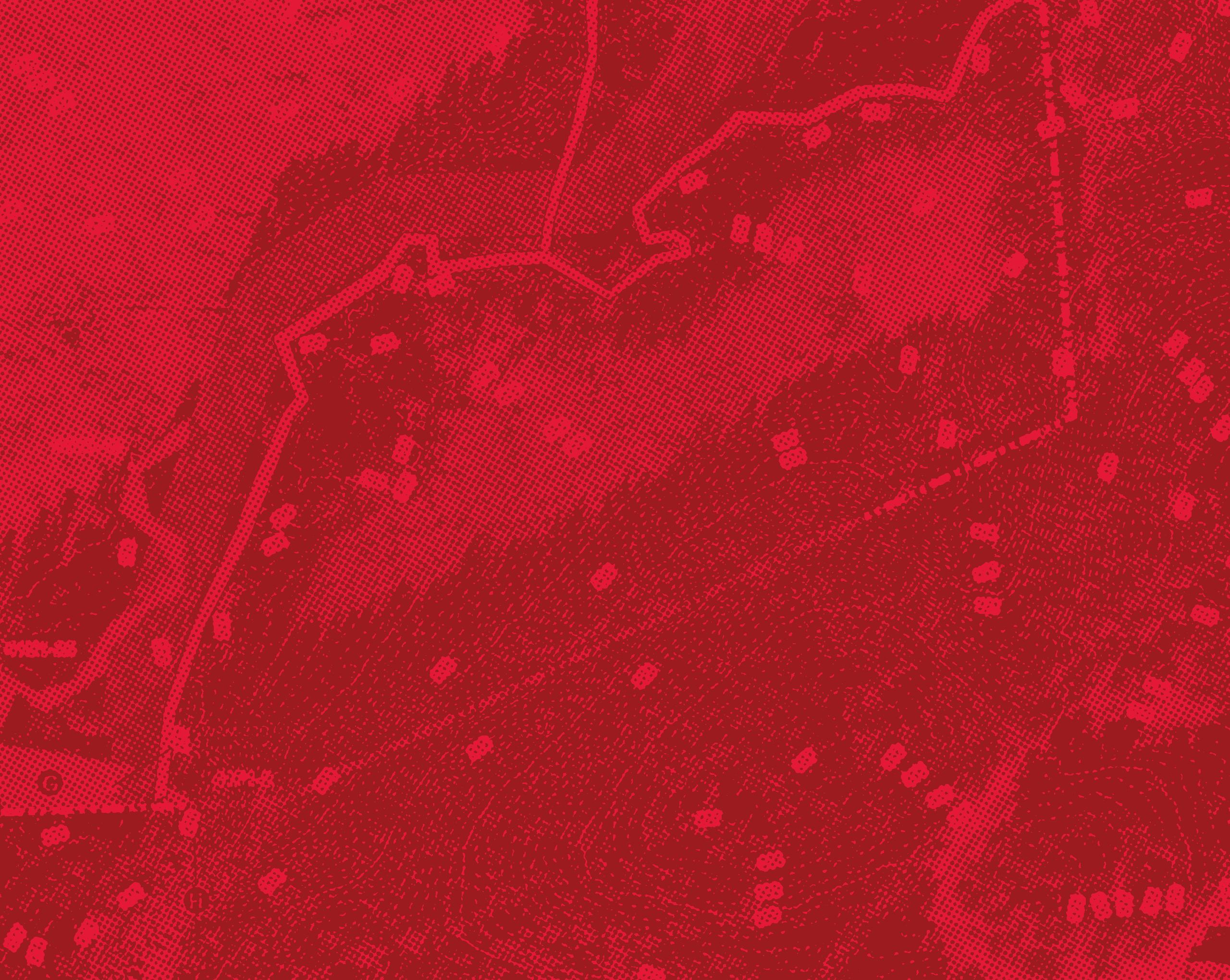
Summary of Sustainable Site Development Strategies
The Office of Partnerships and Initiative for Community Growth + Development
1
Contents 2 4 6 10 18 41 Overview Ecosystem Services Benefits FDB Phase One Site Development Strategy FDB Phase One Summary of Ecosystem Benefits Ecosystem Services Strategies Budgets
In November 2021, shortly after FujiFilm Diosynth Biotechnologies began construction on their Galaxy site in Holly Springs, NC, the NC State University Initiative for Community Growth and Development offered recommendations on strategies that the company could deploy to achieve sustainable site development. The November recommendations were in addition to a Baseline Ecosystem Services Assessment report, completed by the Initiative and subcontractor EcoMetrix Solutions Group (EMX).
The Ecosystem Services Assessment included a limited scan of the project area to develop a high-level understanding of site context. Field work was completed to collect biophysical baseline data related to vegetation, soils, and hydrology so NC State could generate and evaluate ecosystem service quantification models. NC State also identified and collected data from nearby reference sites as comparative resource for benchmarking. The reference site was selected based on current on-site habitat types as well as habitat types potentially present previously on the FDB Galaxy site in addition to other habitat types in the general area that may be important for meeting community objectives and establishing performance targets. Specifically, for this phase of work, outputs have been expressed in the “percent performance” unit of measure. It is the “delta” or difference between the Business As Usual and the other two quantification measurements that generates a performance gap in ecosystem service benefits.
NC State then identified design development strategies that FujiFilm Diosynth Biotechnologies (FDB) could implement to close performance gaps in ecosystem service benefits for the Galaxy project site as it builds out its manufacturing facility in Holly Springs, North Carolina. The purpose in sharing that information was to provide a framework for considering the merits of each design strategy. As FDB has completed the design of the project site and is now implementing its preferred development strategy, this report summarizes the ecosystem services benefits as one way of measuring progress in achieving site development sustainability goals.
2
Overview
Overview
FujiFilm Diosynth Biotechnologies
This report illustrates the specific sustainability and restoration strategies that FDB has deployed. Included is a revised assessment by EcoMetrix Solutions Group of the selected strategies to evaluate their effectiveness, followed by a detailed description of the measures that were considered and the results of those measures as implemented.
3 Ecosystem Services Benefit 6 Phase 2 Ecosystem Services Benefit
Ecosystem Services Benefits
The following ecosystem service benefits were identified and evaluated by NC State and EcoMetrix Solutions Group within the October 2021 Baseline report.
4
7
1. Air and Climate
2. Soil Health
3. Wellbeing
4. Water Quality
5. Biodiversity
The November 2021 recommendations paired site development strategies that closely correlate with the above benefits, and further described where the strategies could be deployed on the FDB Galaxy Site. NC State provided a rough cost estimate, or budget for each strategy so that FDB could better understand the potential costs for implementing each strategy.
Air Filtration
Carbon Sequestration
Soil Quality
Erosion Regulation
Air Temperature Regulation
Visual Screening
Noise Screening
Water Quality Filtration
Total Nitrogen Removal
Water Quantity Control
Biodiversity Support
Pollinator Support
Food Web Support
5
Phase 2 Ecosystem Services Benefit
FDB Galaxy Phase One: Sustainable Site Strategy
ECOSYSTEM SERVICES ASSESSMENT DEFINED
Jacobs Engineering worked in partnership with FDB to incorporate these sustainable site development strategies into the construction plans for the Galaxy site. Each strategy went through an evaluation, including a detailed design development and budgeting evaluation. The final site development strategy for Phase One of the FDB Galaxy site is illustrated on the following page (Page 7) of this report. A summary of the acres devoted to each strategy is also provided.
Total FDB Galaxy acreage 148. Total acres devoted to full build out (all phases) is approximately 112 acres (disturbed by construction). Approximately 36 acres is devoted to restoration to meet LEED certification goals. Forest restoration is 13 acres. Forest restoration that satisfies Town of Holly Springs landscape buffer requirement is 4.1 acres. Native seed mix and restoration of gravel paved areas is 4.5 acres. Native seeding of gravel access road is 2.6 acres, Native seeding of detention pond is 4.8 acres. Landscape plantings within development footprint is 6.3 acres. Bioretention is 0.6 acres. Pollinator garden is 0.1 acres.
6 FDB Galaxy Phase One: Sustainable Site Strategy
FujiFilm Diosynth Biotechnologies

7
Phase 2 Ecosystem Services Benefit
Figure 1: Red star illustrates location of FujiFilm Diosynth project site.
Ecosystem Services BenefitsFDB Construction
EcoMetrix Units of Measure for the FDB Galaxy Site have been evaluated and are presented in the following report. Outputs have been produced in the “percent performance” unit of measure. EcoMetrix uses this unit to communicate the performance of a landscape relative to the maximum potential performance that could be achieved for a given function or service at a given location on a site. This provides a consistent unit of performance across media and helps to illustrate the push-pull relationships found in natural systems. These relationships are reflected in the fact that scores nearing 100% are almost always the result of engineered solutions intended to optimize performance for a certain purpose (e.g., pavement achieves a 100% score for interception), while that high level of performance comes at the expense of performance in other categories (e.g., pavement scores extremely poorly for biodiversity metrics). For the purpose of evaluating the benefit provided by a given land area, EMX also provides results using a “functional acre” unit of measure. This is simply the percent performance value weighted against the area (in acres) where that level of performance is observed. This approach allows EMX to combine performance with area to communicate both quality and quantity of a given solution—the total amount of benefit that a given land area provides to society.
One key advantage of the functional/service acre approach is that it captures the reality that benefits produced by a site can be stacked (recognizing that the land performs more than one function at a time) to generate performance that easily exceeds the actual acreage of the site. The functional/service acre unit of measure
is particularly useful when trying to understand how much of a given intervention or landscape type would be needed to achieve a desired outcome.
For the benefit production bar charts provided by EMX, the site’s baseline performance is compared to the benefits expected to result from an informed, generic business as usual (BAU) design footprint and four scenarios representing planned improvements across a series of time intervals, which are then compared to an optimized aspirational target that has been informed by a high-level understanding of community priorities.
8
Ecosystem Services Benefits - FDB Construction FujiFilm Diosynth Biotechnologies
Target Mosaic
REFERENCE SITE PERFORMANCE TARGET CONSTRUCTION

The presumed condition (prior to the past few decades of sporadic clearing) was used as the initial basis for mosaic proportions.
Proportions were then adjusted to weight targets toward reference habitats capable of supporting assumed community priorities
Storm water management
Air quality and carbon uptake/sequestration
Forest and wildlife habitat/ biodiversity
Water quality protection
Erosion control and soil quality
Health wellbeing – access to passive recreation
Access to healthy foods (not yet incorporated, but can be added at micro-level as part of design)
This contextual weighting process reduces forest cover in the target condition while increasing wetland and stream proportions to make up the difference.
9
Phase 2 Ecosystem Services Benefit
AIR AND CLIMATE

In the baseline condition, forest regeneration areas in the central portion of the site were previously cleared and mulched resulting in robust secondary growth which drove high levels of air quality and carbon sequestration performance. However, mature reference conditions with dominant trees in less active growth stages and less dense understory still perform beyond the baseline condition for air quality. Restoration projections for 10-15 yrs. and 15 yrs.+ transitioned to more mature forests resulting in improvements to air quality performance over time. Mature forests (Restoration, 15 yrs.+) store more carbon than other scenarios but see a decline in the rate of uptake resulting in a slight reduction of carbon sequestration performance.
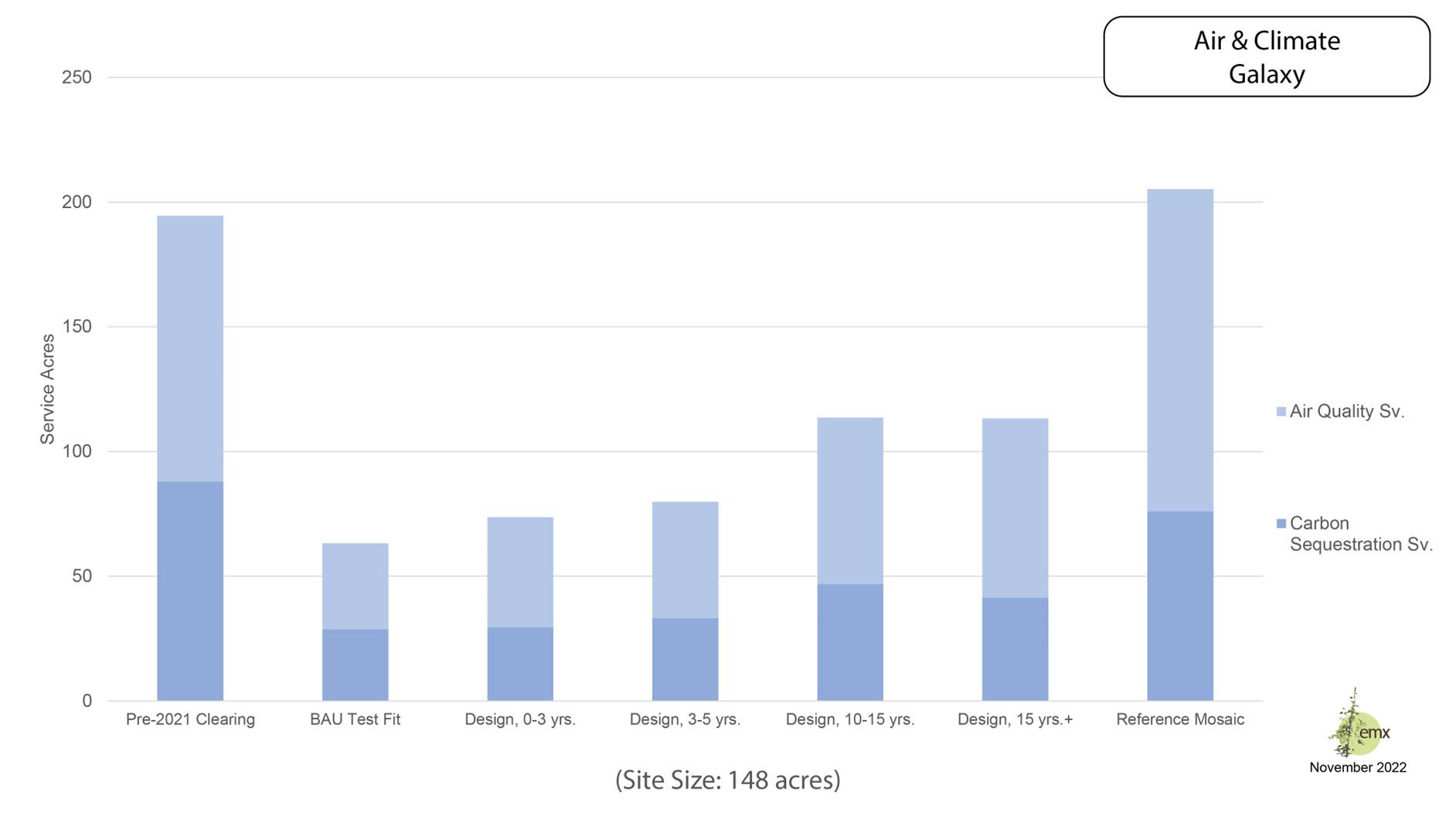
10
Ecosystem Services Benefits - FDB Construction FujiFilm Diosynth Biotechnologies
BIODIVERSITY
In the baseline condition, forest regeneration areas in the central portion of site were previously cleared and mulched resulting in robust secondary growth which drove performance for support of several species groups beyond the reference condition. Restoration scenarios were assumed to have begun with the Revised BAU Test Fit scenario followed by continuous growth without disturbance to restored areas. Increased structural diversity over time (e.g., increased aerial and ground cover across vegetation types; increased litter/duff, downed wood, and snags; growth of vegetation cover in ponds and streams; etc.) provides a greater mosaic of habitat support options for a wider range of species.
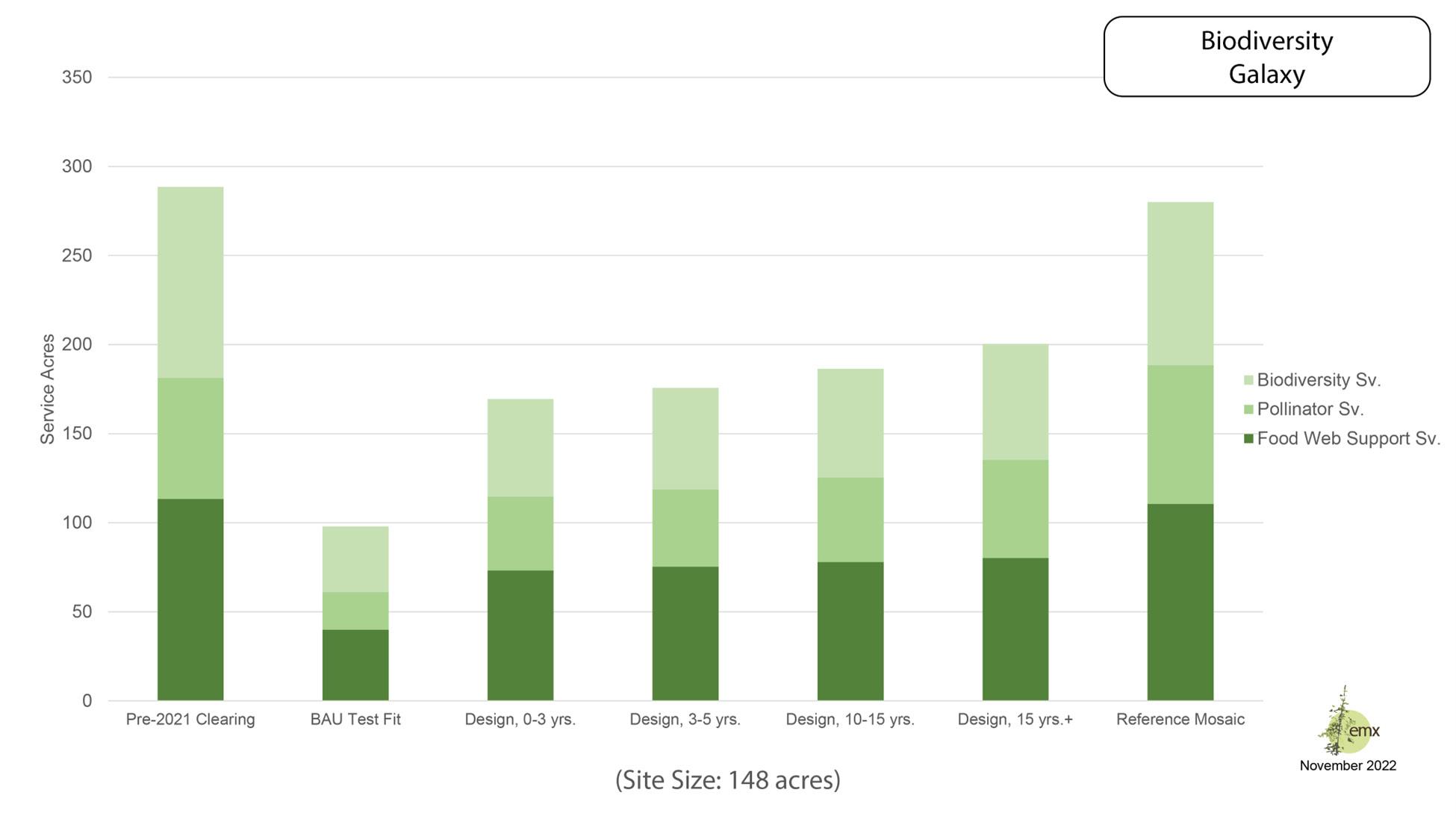
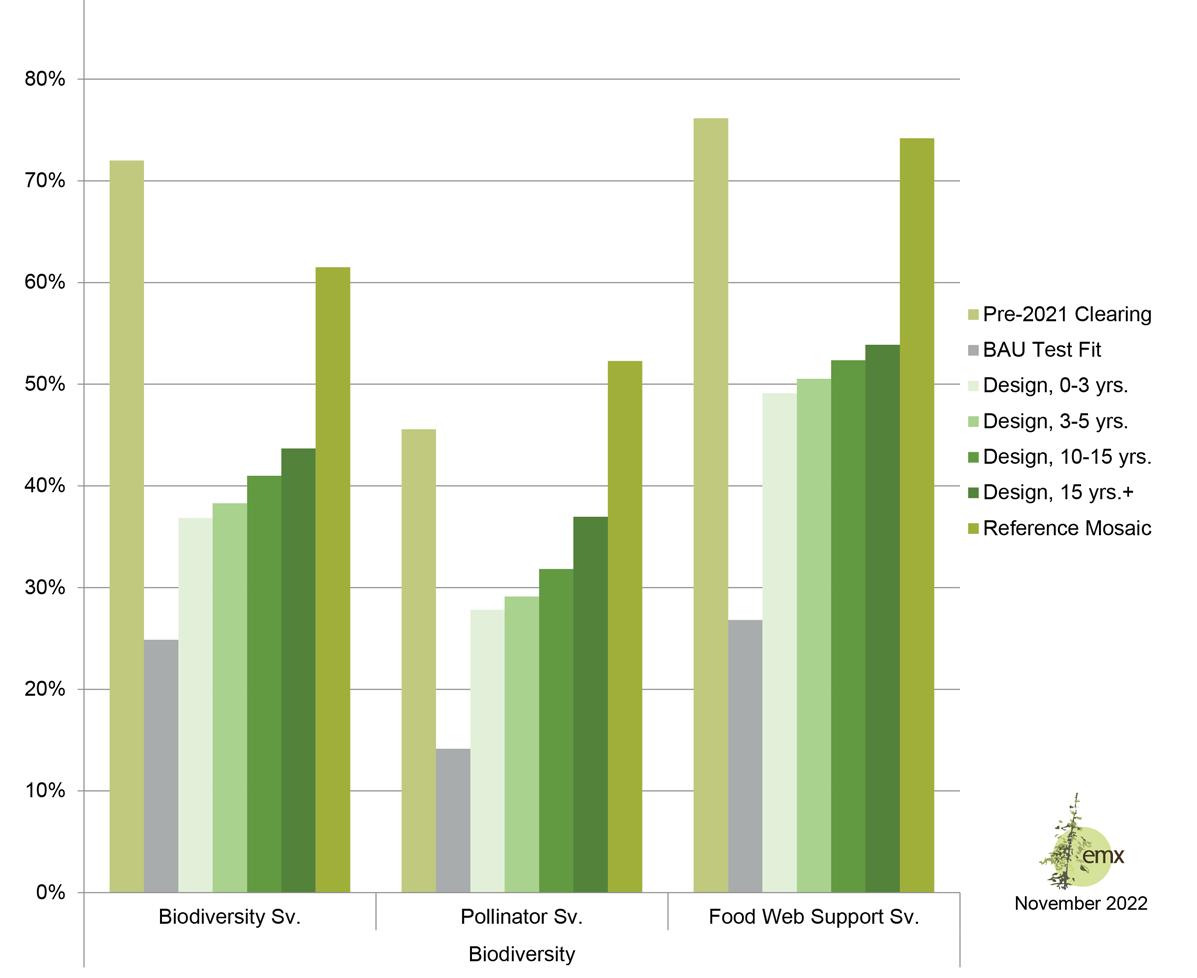
11
Phase 2 Ecosystem Services Benefit
WELLBEING

Higher basal density and canopy cover drive up the air temperature regulation performance as well as the noise and visual screening performance for the baseline and reference conditions relative to BAU. Restoration plantings were intended to approach previous conditions over time, in terms of denvsity of stems per unit of area; thus, early growth after initial planting is assumed to provide a minimal screening benefit, which will improve over time, but provides an immediate improvement over BAU conditions, where the vegetation was removed.

12
FujiFilm Diosynth Biotechnologies Ecosystem Services Benefits - FDB Construction
Dense basal and aerial cover, along with a substantial litter and duff layer in areas that were previously cleared/mulched, drive soil values for the baseline condition above reference. This is, in part, because the reference condition has more exposed surface that is not as extensively covered by organic material. BAU increases impervious surfaces while decreasing natural soil quality and quantity, though these conditions do provide useful stabilization against erosion in areas capped by hardscape. Restoration scenarios add basal ground cover and litter/duff which, along with improvements to infiltration and soil stability, result in improved soil health.


13
SOILHEALTH
Phase 2 Ecosystem Services Benefit
WATER QUANTITY AND QUALITY
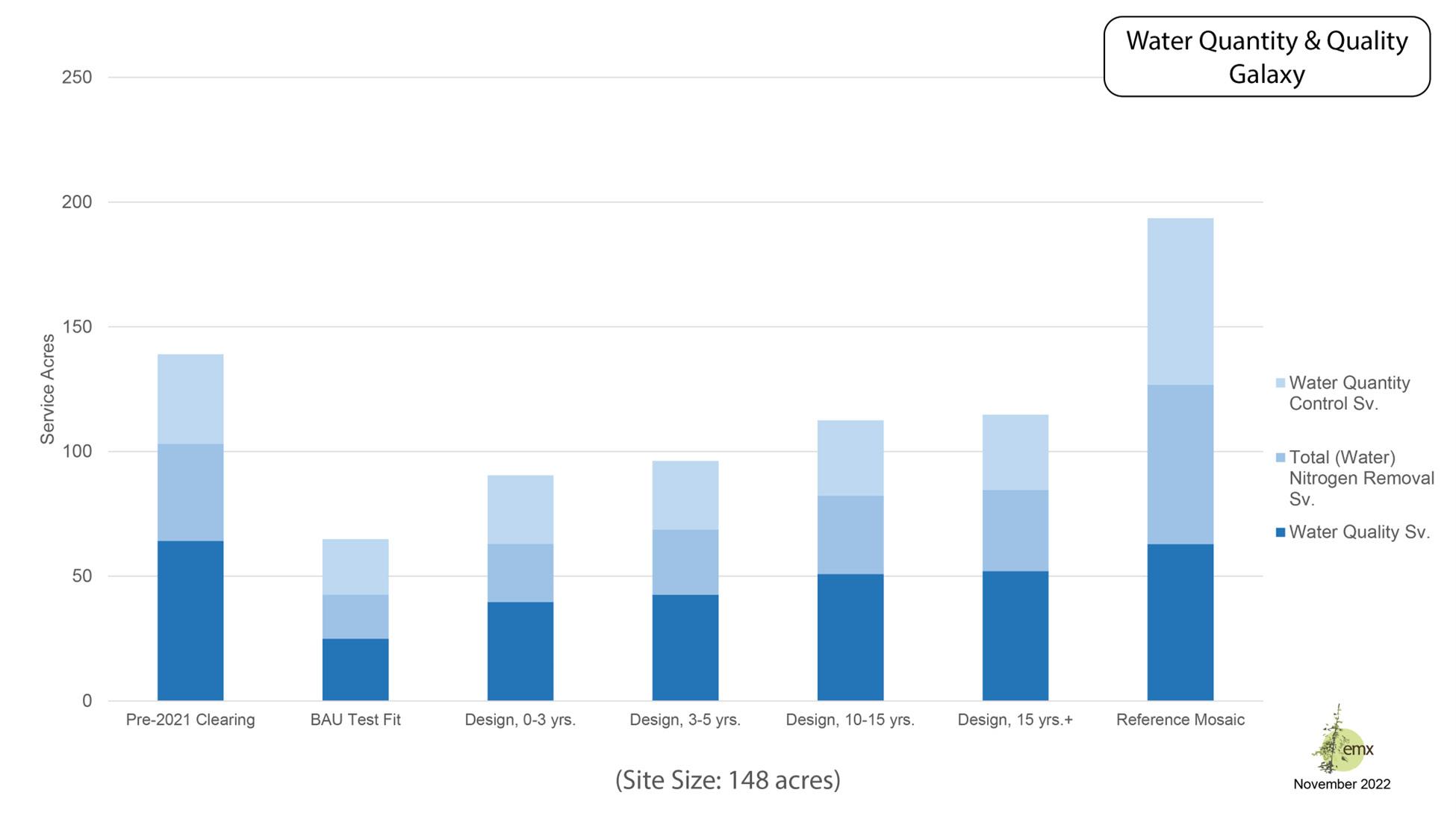
High vegetative basal density values, depressional areas, and significant ground cover (litter/duff, etc.) drive performance values for the baseline and refence site conditions. Increased impervious surfaces associated in the BAU condition drive down the scores of all three water services relative to the baseline or reference conditions while water quantity control impacts are somewhat limited by assumed detention structures in that design. These detention structures remain in the restoration scenarios; however, recovery of vegetation and associated outcomes (litter/duff, basal density, etc.) supports rebounds in water quantity and quality.

14
FujiFilm Diosynth Biotechnologies Ecosystem Services Benefits - FDB Construction
CORE SERVICES
Within this analysis, baseline performance frequently exceeded that of even the reference condition where forest regeneration supported robust secondary growth leading to favorable conditions for many services. Natural area lost to clearing of vegetation, increased man-made impervious and previous surfaces, and the loss of some stream channel area are the major drivers for the service values in the BAU condition. Established vegetation drives services higher in the baseline, reference mosaic, and the more mature restoration scenarios. Over time, regrowth from restoration efforts increases structural attributes that provide support mechanisms for biodiversity and other services.
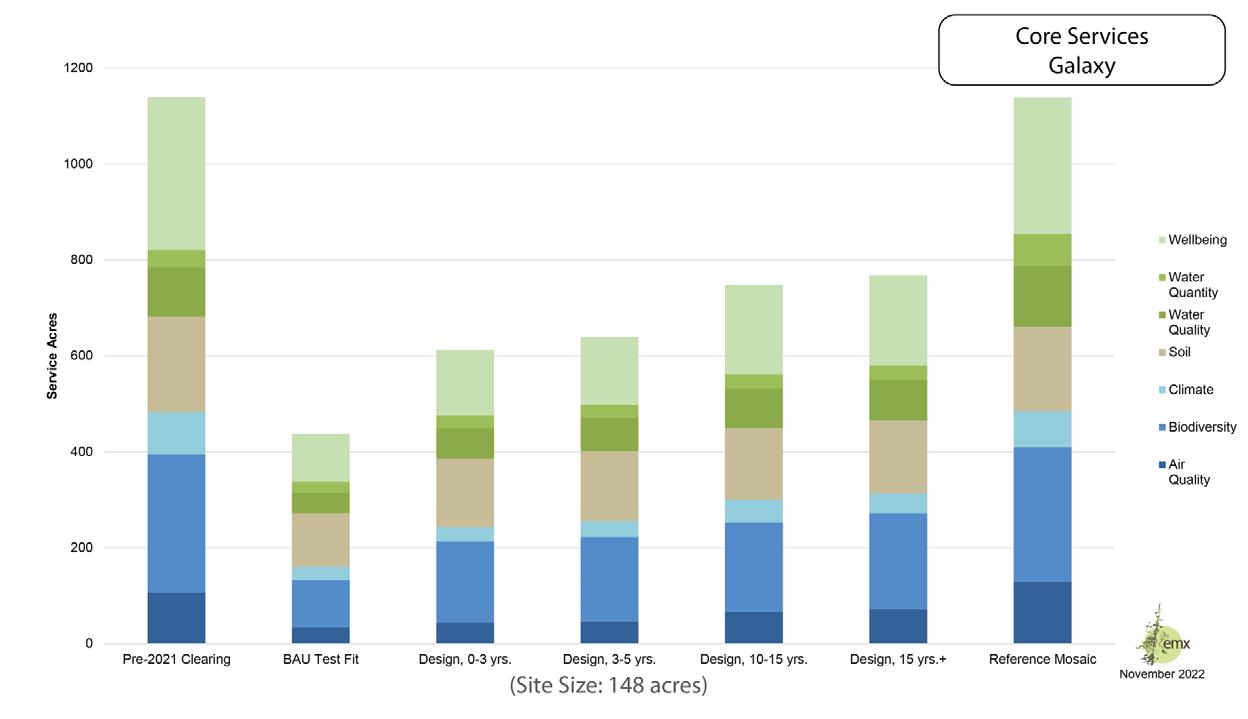

15
Phase 2 Ecosystem Services Benefit
High-Level Notes
BAU scenario assumes traditional engineering designs for the site development footprint
1. BAU is not heavily influenced by sustainability measures in an effort to provide a reference point
2. The remainder of the site, outside of clearing footprint, is assumed to stay “as-is” for initial restoration scenarios but adjusted for continued growth for later time intervals
The reference site target performance scores are driven by a reference site mosaic constructed in response to presumed community priorities

1. This prioritization results in a decrease in forest cover and an increase in aquatic map unit proportions, which decreases performance for a suite of forest-related benefits, but increases performance for other benefits associated with aquatic systems (which occupy a smaller percentage of the landscape)
2. For some measures, the baseline condition actually outperforms the target because, while perhaps culturally unappealing, the dominance of highly productive shrub-scrub/young forest regen areas drives very highperformance scores for some measures
3. Restoration efforts provide immediate benefit above the performance of the BAU but remain below original baseline values due to developed area replacing vegetated areas.
16
FujiFilm Diosynth Biotechnologies High Level Notes

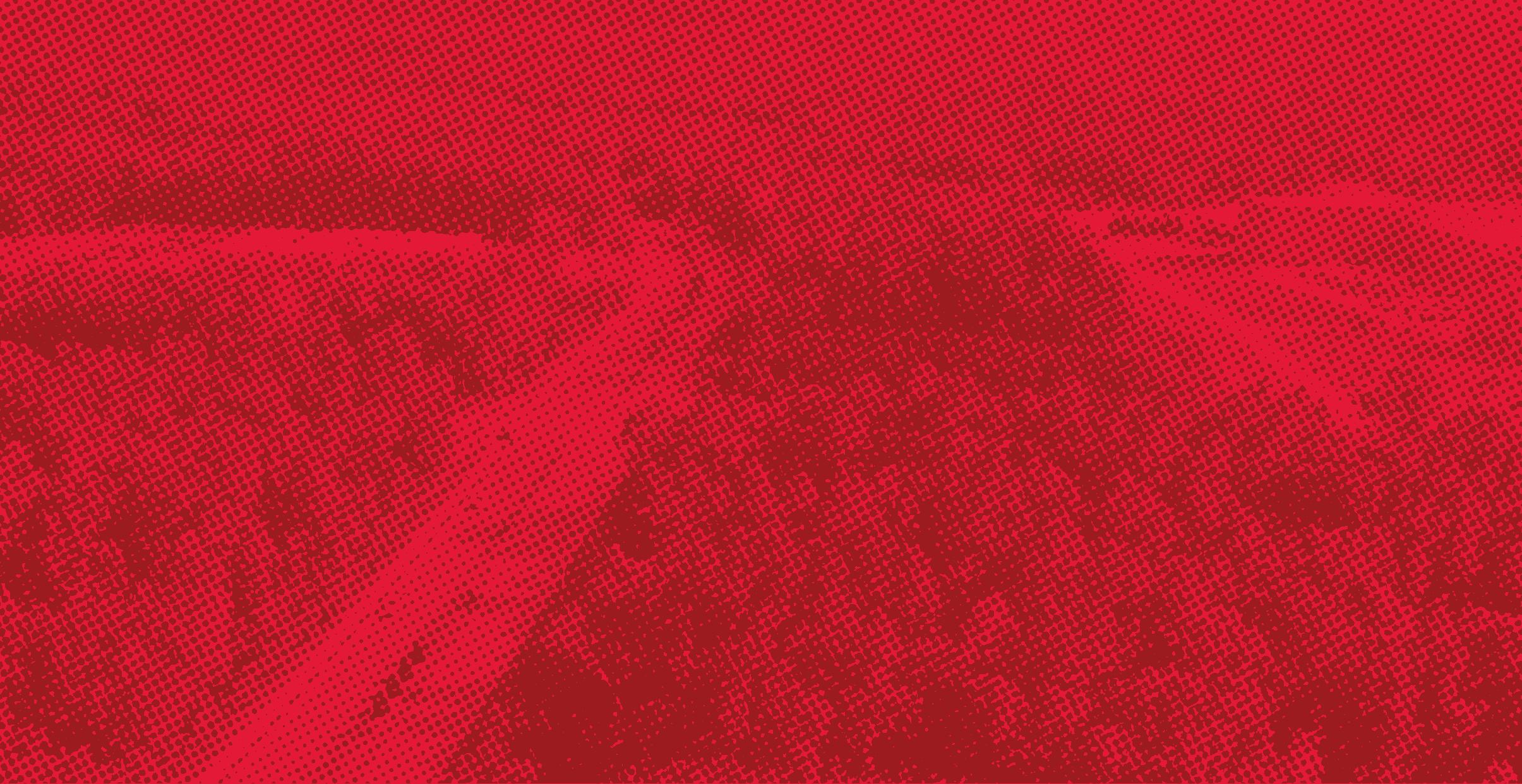
17 18
Specific Ecosystem Services Strategies
In November 2021, NC State recommended a specific set of strategies that FDB might consider for inclusion to meet the company’s sustainability goals.
1817
The specific design development solutions, the ecosystem service benefits that they can provide, and where each strategy might be deployed within the Galaxy project site is described in greater detail on the following pages. Additionally, NC State connected FDB with several resource professionals both within NC State University and in the community at-large. The results of those meetings is summarized on the following pages. The list of specific sustainability strategies considered is as follows:
Temporary Wildflower Meadow
Temporary Sunflower Garden
Landscape Planting Plan
Forest Restoration
Habitat Restoration
Aquatic Restoration
Bioretention and Bioswales
Permeable Pavement
• Infiltration Trenches
• In-Channel Multi-Cell Wetland
• Adjacent to Channel Wetland
• Green Roof
19
Temporary Wildflower Meadow
ECOSYSTEM SERVICES BENEFIT
Carbon Sequestration
Insect Support
Wildlife Attractor: Pollinators
Storm water Management
Air Temperature
Air Quality
Nitrogen Removal
Phosphorus Removal
AREA OF FDB GALAXY SITE FOR THIS APPLICATION
As site grading is completed, FDB will be required to stabilize graded soil areas with a temporary or permanent vegetation, as part of the soil erosion and sediment control strategy. For areas of the FDB site that will not be developed in Phase 1 and 2 of manufacturing construction (Phase 3 and beyond), FDB could choose to seed graded areas with a wildflower mix instead of a more traditional mix of grass and other legumes. If this strategy is deployed, the ecosystem service benefits would be beneficial for insects and pollinators and could include a range from carbon sequestration to air quality benefits. The
optimal time for seeding wildflower mix is in the fall of each year. However, the seed can be applied anytime of the year with proper irrigation measures. For purpose of discussion 20 acres of the project site is included as possible temporary Wildflower field.
NC State connected FDB with NC State alumnus and the founder of Bee Downtown, Leigh-Kathryn Bonner. Bee Downtown is a Durham-based company that installs and maintains beehives. Based on the conversation with Bee Downtown, FDB committed to installing a pollinator garden on a portion of the FDB Galaxy site. The specific recommendations of that pollinator garden are provided on the following page of this report.

20
FujiFilm Diosynth Biotechnologies Specific Ecosystem Services Strategies
POLLINATOR GARDEN – FDB GALAXY SITE
FDB will install a pollinator garden in front of one of the project buildings. The pollinator garden will contain a mix of wildflowers. FDB may install on-site beehives on the campus and if this is implemented, the company intends to manage their own beehives. The original NC State recommendation was to set aside as much as 20 acres for a wildflower meadow, but that was deemed not to be feasible given the future site development priorities of FDB.
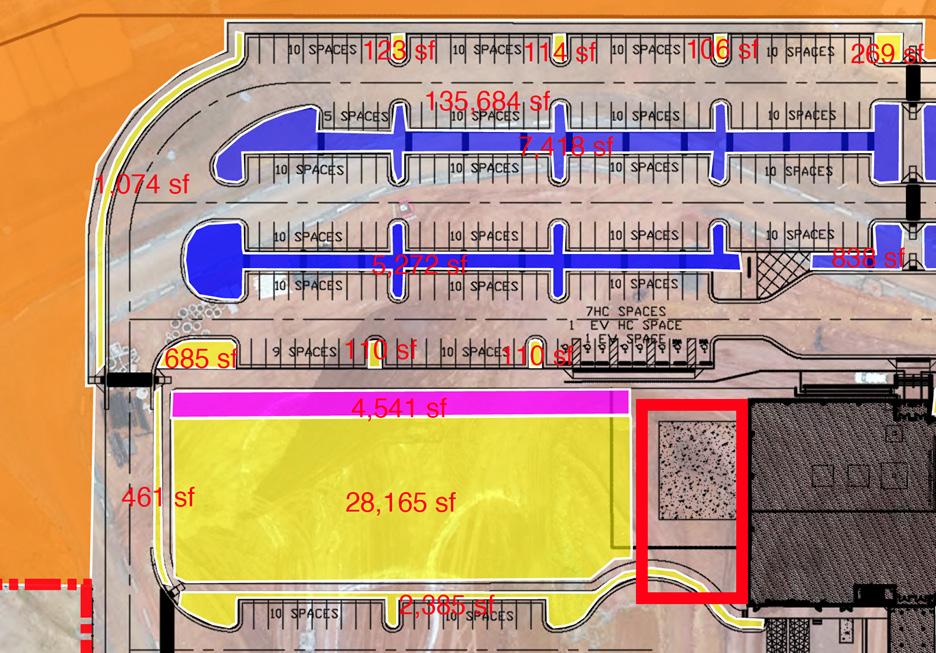
21
Figure 2: The pollinator garden is shown in bright pink on the above drawing. A total of 0.1 acres of land is devoted to this strategy.
Phase 2 Ecosystem Services Benefit
Temporary Sunflower Crop
ECOSYSTEM SERVICES BENEFIT
Carbon Sequestration
Insect Support
Wildlife Attractor: Pollinators
Storm water Management
Air Temperature
Air Quality
Nitrogen Removal
Phosphorus Removal
AREA OF FDB GALAXY SITE FOR THIS APPLICATION
An alternative strategy for graded soil areas in Phase 3 and beyond would be to establish a temporary crop of sunflowers. If this strategy is deployed, the ecosystem service benefits would be similar as with wildflower mix. The sunflower crop would also produce sunflower seed and sunflower oil byproduct. The optimal time for establishing the sunflower crop is in the late winter and early spring of each year. Sunflowers germinate when the soil temperature reaches 70 degrees. Harvesting sunflowers could produce a useful agricultural product that could
be donated or sold to local food producers. The rate of seeding is 3 to 4 pounds per acre, producing 15,000 to 20,000 plants per acre. For purpose of discussion 20 acres of the project site is included as possible temporary Sunflower field.

NC State offered to have the College of Agriculture and Life Sciences provide technical assistance to FDB in regard to the planting of a sunflower crop. This strategy was not pursued by FDB as it was not a practical use of the company’s corporate campus.

22
FujiFilm Diosynth Biotechnologies
Specific Ecosystem Services Strategies
Landscape Plantings
ECOSYSTEM SERVICES BENEFIT
Carbon Sequestration
Insect Support
Songbird Support
Small Mammal Support
Wildlife Attractor: Pollinators
Storm water Management
Air Temperature
Air Quality
Nitrogen Removal
Phosphorus Removal
AREA OF FDB GALAXY SITE FOR THIS APPLICATION
Landscape plantings are an important part of the manufacturing plant experience. Landscape plantings reinforce the corporate image, enable workers to engage with the FDB landscape, accentuate building architecture, conserve energy and water, cool air temperatures by providing shade, and support biodiversity for the Galaxy project site.
As FujiFilm Diosynth Biotechnologies is a joint endeavor of companies with origins in Japan and Denmark, it is worthwhile to consider the cultural significance of landscape design in both countries. In Japan, there tend to be four essential elements used in landscape design: rock, water, plants, and ornaments. The main design principles of a traditional Japanese landscape include asymmetry, enclosure, borrowed scenery, balance and symbolism. A properly designed landscape planting plan will incorporate all these elements throughout the project site.
The principles of Danish landscape architecture are closely aligned with the values and practices found within likeminded European nations. The emphasis of design development is rooted in landscape conservation. Where landscapes are manipulated, such as for formal garden design, symmetry, balance, and order are incorporated in design development strategies. Native plant material is utilized, and nature is revered.
The Danish and Japanese cultural values inform expectations and outcomes for the Galaxy project site landscape planting design. The landscape structure and available space of the site is defined by manufacturing plant layout and design, and the utilitarian functions of roads, parking lots and utilities that support the manufacturing plant. Therefore, landscape plantings must be carefully executed in order to appropriately represent cultural values. This can be achieved through detailed design and the selection of plant materials. A landscape planting plan will be implemented by FDB across the entire 146-acre disturbed project site. Areas of landscape planting emphasis can occur at the entrance to the project site and along the perimeter of the site. For purpose of discussion 40 acres of the project site is identified as requiring landscape plantings.
From an ecosystem services benefit perspective, the use of native and ornamental plants are appropriate. Emphasis should be placed on those materials that assist with carbon sequestration, air quality, water quantity and water quality. Support for birds, small mammals and insects is another important consideration.
From a human perspective, landscape plantings can reinforce Zen and serve as areas for respite, refuge and renewal of body and mind. NC State offered to have the College of Design assist FDB and Jacobs Engineering in the design, layout and development of a landscape planting program for the FDB Galaxy site. While this has not been pursued, FDB will install a range of landscape plants as part of its campus landscape plan that meet the spirit and intent of this recommendation. The specific implementation strategy is illustrated on the following pages of this report.
23
Phase 2 Ecosystem Services Benefit
Landscape Planning Strategies
Jacobs Engineering has proposed a specific landscape planting plan for the areas that are highlighted in yellow.
24

25 Phase 2 Ecosystem Services Benefit
Native Forest Restoration
ECOSYSTEM
SERVICES BENEFIT
Carbon Sequestration
Atmospheric Cleaning
Wildlife Habitat Support
Songbird Support
Storm water Management
Evaporation
Air Filtration
Biodiversity Support
AREA OF FDB GALAXY SITE FOR THIS APPLICATION
The perimeter of FDB Galaxy site contains immature Loblolly pine forest. This forest can be cared for through an active stewardship program to improve the quality of the forest and the diversity of tree species that are grown. Historically, the FDB site contained different forest types, from native Longleaf Pine, to cotton and tobacco farming, to mixed hardwood deciduous and to the present-day Loblolly pine forest.
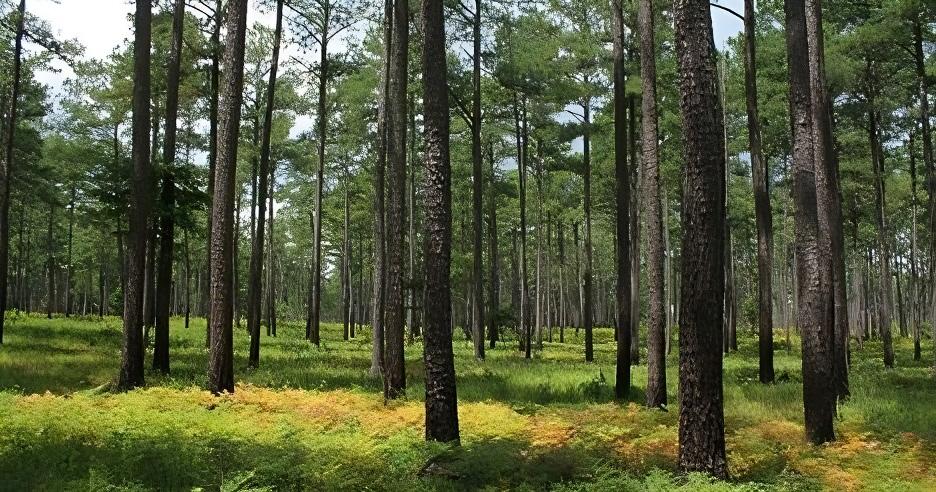
The loss of the immature forest across 112 acres of the project site is one of the most significant impacts on ecosystem service benefits. Working to improve the health and function of the remaining
36 acres that surrounds the core of the Galaxy site should be a priority for FDB. For purpose of discussion 36 acres of the project site is identified as needing forest restoration. NC State University can work in partnership with FDB to restore and steward the forest that in turn could produce a plethora of desired ecosystem service benefits.
26
Forest restoration areas across the FDB Galaxy site are shown in the colors orange, brown and dark green. There are various strategies for how these areas will be restored, including installing new seedlings and overseeding the landscape with a special mixture of native grasses to serve as an immediate ground cover to arrest soil erosion. One recommended restoration strategy will involve using the on-site native borrow soil as a seed bed for both native grasses and seedlings. The native soil also contains latent seed that will germinate naturally within the next year.

27
The native grass seed mix below will be applied in specific areas across the project site. It contains a variety of grass types that will germinate under the varied site conditions providing a permanent cover.

28 FujiFilm Diosynth Biotechnologies
Specific Ecosystem Services Strategies
Native grasses will provide a permanent groundcover throughout the Galaxy site.
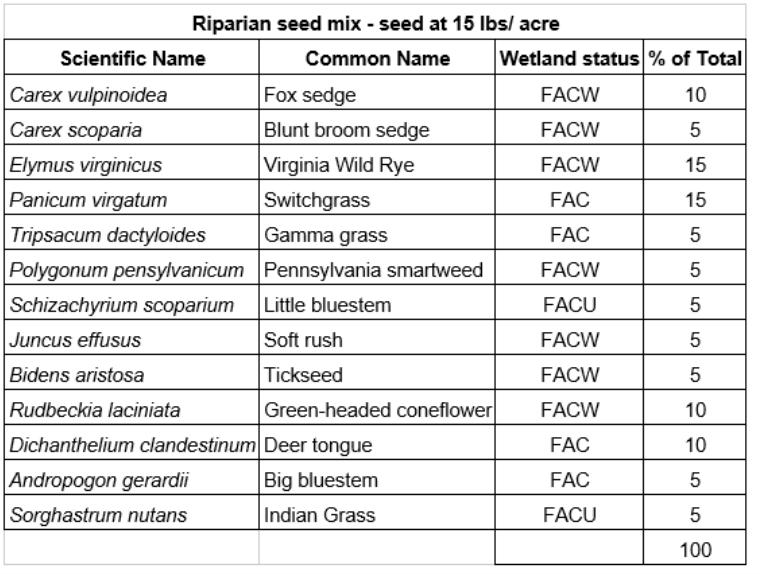
29
Phase 2 Ecosystem Services Benefit
Gaps in existing forest (photo below) disturbed by construction will be restored.

Larger areas of the site that were denuded prior to Galaxy site construction and disturbed by construction will be restored with a mix of pine and hardwood forest seedlings.

30
FujiFilm Diosynth Biotechnologies Specific Ecosystem Services Strategies
Wildlife Habitat Restoration
ECOSYSTEM SERVICES BENEFIT
Biodiversity Support
Insect Support
Songbird Support
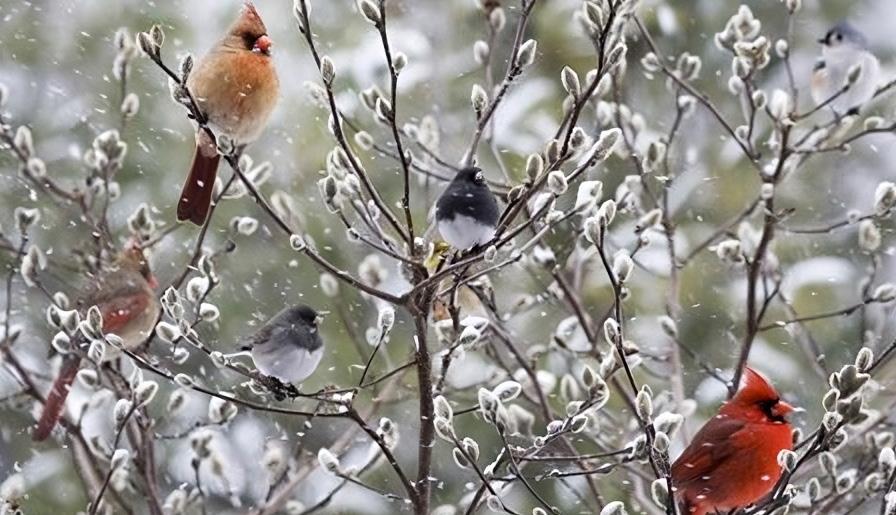
Water Filtration
Wildlife Attractor: Pollinators
Passive Recreation
AREA OF FDB GALAXY SITE FOR THIS APPLICATION
Wildlife viewing is one of the most sought-after outdoor activities in the United States. Most of the 146-acre site has been cleared of valued habitat. So ecosystem support for wildlife has been substantially reduced. Some habitat enhancement work could involve planting new species of trees, shurbs, and other understory vegetation capable of supporting a diversity of wildlife habitat. For purpose of discussion 36 acres of the project site is identified as requiring habitat restoration.
NC State University offered to have the College of Natural Resources and
College of Agriculture and Life Sciences work in partnership with FDB and Jacobs to define wildlife habitat enhancements that will benefit a diversity of wildlife. Support for wildlife can be paired with Holly Springs community outreach and educational programs. FDB chose to work with the North Carolina Agricultural Extension program. Two certified foresters visited the FDB Galaxy site and offered recommendations on how to restore the landscape to meet the needs of diverse wildlife. The landscape planting plan provided by Jacobs also offers a mix of plant species that will provide a food source for wildlife.
31
Phase 2 Ecosystem Services Benefit
Aquatic Restoration

ECOSYSTEM
SERVICES BENEFIT
Carbon Sequestration
Water Quality
Wildlife Attractor: Pollinators
Water Temperature
Storm water Management
Water Quantity
Biodiversity Support
Aquatic Habitat Support
Ground Water Recharge
Storage of Water
AREA OF FDB GALAXY SITE FOR THIS APPLICATION
The perimeter of the FDB Galaxy site contains impacted aquatic landscapes in the form of wetlands, streams and floodplains, that are capable of being restored. The restoration can be pursued through passive and active strategies. Passive strategies would rely on nature to run its course. Active strategies would involve FDB investing in site construction to more quickly restore ecosystem services functions for the impacted landscapes. For purpose of discussion 50 acres of the project site is identified as requiring aquatic restoration. These landscapes are located around the perimeter of the Galaxy project site.
NC State offered to have the Colleges of Agriculture and Life Sciences and Natural Resources assist FDB with identifying detailed restoration strategies for the impacted aquatic landscapes. Dr. Barbara Doll visited the project site and offered recommendations for how and where to restore aquatic landscapes. While this is not something that FDB intends to pursue in this phase of development, the opportunity exists to accomplish this work at a later date.
32
FujiFilm Diosynth Biotechnologies Specific Ecosystem Services Strategies
Bioretention and Bioswales
ECOSYSTEM SERVICES BENEFIT
Storm water Management
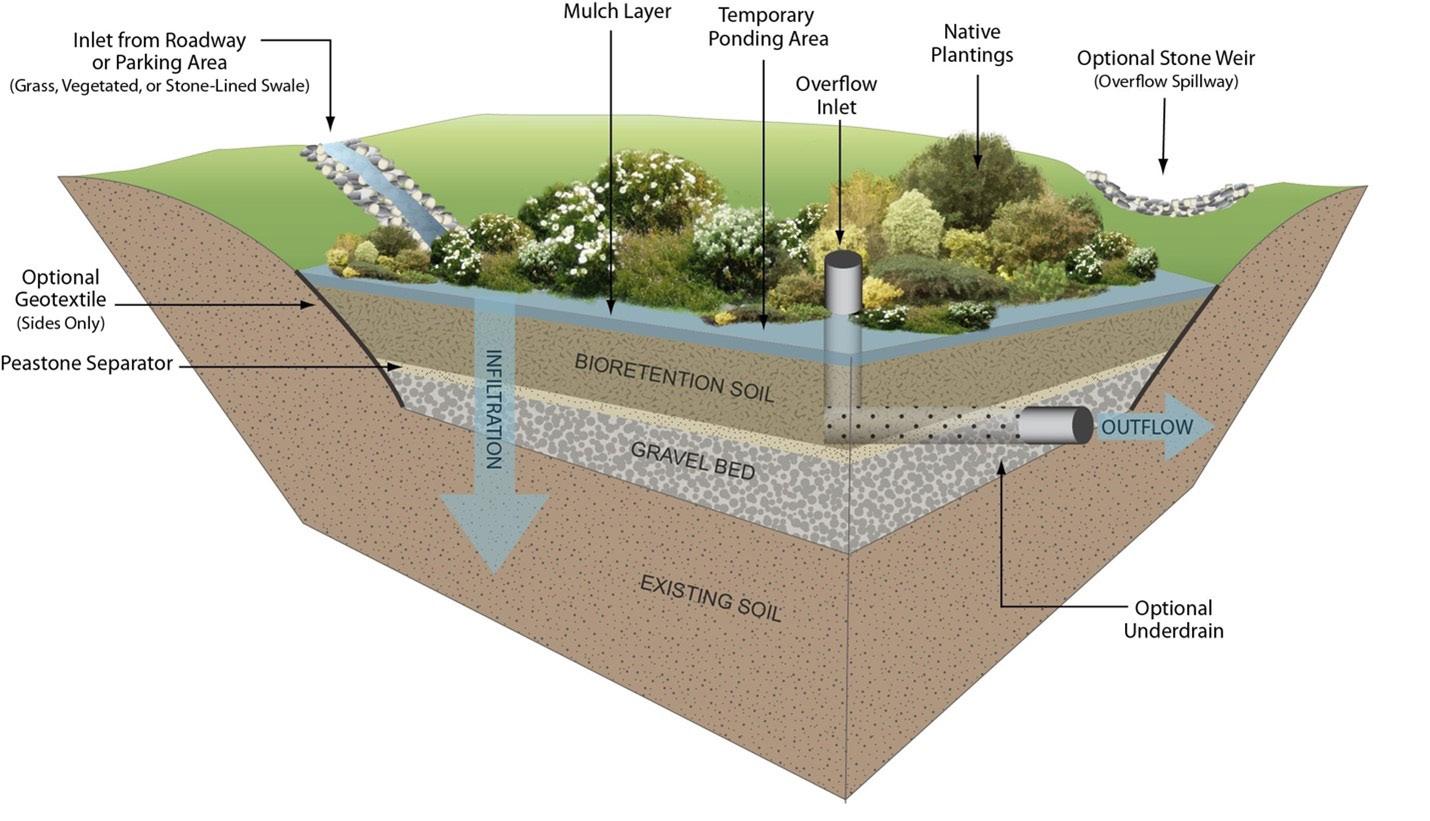
Water Quality
Phosphorus Removal
Nitrogen Removal
Water Quantity
Interception
Infiltration
Biodiversity Support
Evaporation
Water Temperature
AREA OF FDB GALAXY SITE FOR THIS APPLICATION
Bioretention areas can also be referred to as rain gardens. These landscapes make use of soil, plants and microbes to treat stormwater removing pollutants and sedimentation before it is discharged from the project site. Often bioretention area are shallow depressions filled with sandy, permeable soil topped with mulch or other dense vegetation. Jacobs Engineering has recommended using bioretention landscapes throughout the developed 112 acres of the FDB Galaxy site. For Phase One development, 0.6 acres is planned for bioretention. As future phases are developed, it is the goal
to grow this to more than 2 acres of bioretention. Most of this will occur within the parking lots planned for the project site.
The NC State University Engineering Group that specializes in Low Impact Development, led by Dr. William Hunt, met with Jacobs to discuss strategies for implementing a variety of low impact development solutions across the Galaxy site. FDB and Jacobs Engineering evaluate various design development strategies for bioretention and determined to implement these solutions where they would be most effective.
33
Phase 2 Ecosystem Services Benefit
Bioretention for FDB Galaxy Site
After extensive analysis by Jacobs, FDB has decided to incorporate bioretention solutions in the primary employee parking lot. The bioretention is illustrate within the drawing below, in the blue colored areas.

34
FujiFilm Diosynth Biotechnologies
Specific Ecosystem Services Strategies
Bioretention performs as a rain garden, capturing and retaining polluted stormwater runoff for a specific amount of time to allow for natural infiltration into the soil layer.
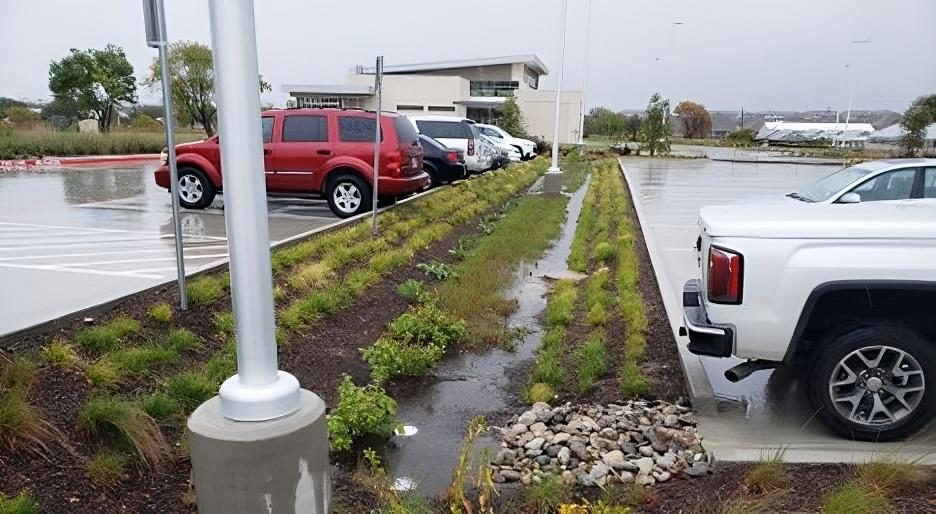
35 Phase 2 Ecosystem Services Benefit
Permeable Pavement
ECOSYSTEM SERVICES BENEFIT
Storm water Management
Water Quality
Phosphorus Removal
Nitrogen Removal
Water Quantity
Interception
Infiltration
Evaporation
AREA OF FDB GALAXY SITE FOR THIS APPLICATION
Permeable pavement is comprised a porous material that enables storm water to flow through it or nonporous paving blocks, bricks or stones spaced so that water can flow between gaps. Permeable paving can also include a variety of surface techniques for roads, parking lots, and pedestrian walkways.

Originally, Jacobs Engineering recommended using permeable pavement in certain areas of the FDB Galaxy site. The original goal was to install approximately 0.97 acres of permeable pavement in certain parking
lot areas of the site. Jacobs met with NC State University Professor Bill Hunt to discuss the proposal and it was eventually determined that permeable pavement would not work for the FDB Galaxy site due to finished grade soil conditions. While this strategy was not deployed in the Phase One development, it remains a strategy worth evaluating for future phases of construction.
36
FujiFilm Diosynth Biotechnologies Specific Ecosystem Services Strategies
Infiltration Trenches
ECOSYSTEM SERVICES BENEFIT
Storm water Management
Water Quality
Interception
Infiltration
AREA OF FDB GALAXY SITE FOR THIS APPLICATION
An infiltration trench can also be thought of as a dry swale, typically filled with washed stone or gravel. These trenches are used around buildings to convey storm water runoff.

Jacobs Engineering recommended using infiltration trenches in specific areas of the FDB Galaxy site. A total of 0.33 acres of infiltration trenches was initially recommended mostly adjacent to the building complex.
NC State offered to have Professor Bill Hunt and his Engineering Group work
with FDB and Jacobs Engineering to evaluate specific design development strategies for infiltration trench landscapes. While this is not part of the Phase One development strategy for the Galaxy site, it remains a development option to consider for future phases of site work.
37
Phase 2 Ecosystem Services Benefit
In Channel, Multi-Cell Constructed Wetland
ECOSYSTEM
SERVICES BENEFIT
Storm water Management
Water Quality
Phosphorus Removal
Nitrogen Removal
Water Quantity
Interception
Infiltration
Biodiversity Support
Evaporation
Water Temperature
Carbon Sequestration
Food Chain Supply
Insect Support
Songbird Support
AREA OF FDB GALAXY SITE FOR THIS APPLICATION
Multi-cell wetlands are constructed to treat stormwater runoff. These wetlands can absorb different discharge flows and serve as a biofilter in the landscape, removing harmful pollutants, suspended solids, and nutrient loads from stormwater before the discharge reaches a native stream channel. For purpose of discussion 1 acre of the project site on the eastern portion of the site is identified as a possible location for an in-channel multi-cell constructed wetland.
NC State offered to have Professor Bill Hunt and Dr. Barbara Doll work with FDB
to evaluate specific design development recommendations for implementing an in-channel constructed wetland project. While this was not pursued as part of the Phase One strategy, it can be considered for future phases of site development.

38 FujiFilm Diosynth Biotechnologies
Specific Ecosystem Services Strategies
Adjacent to Channel Constructed Wetland
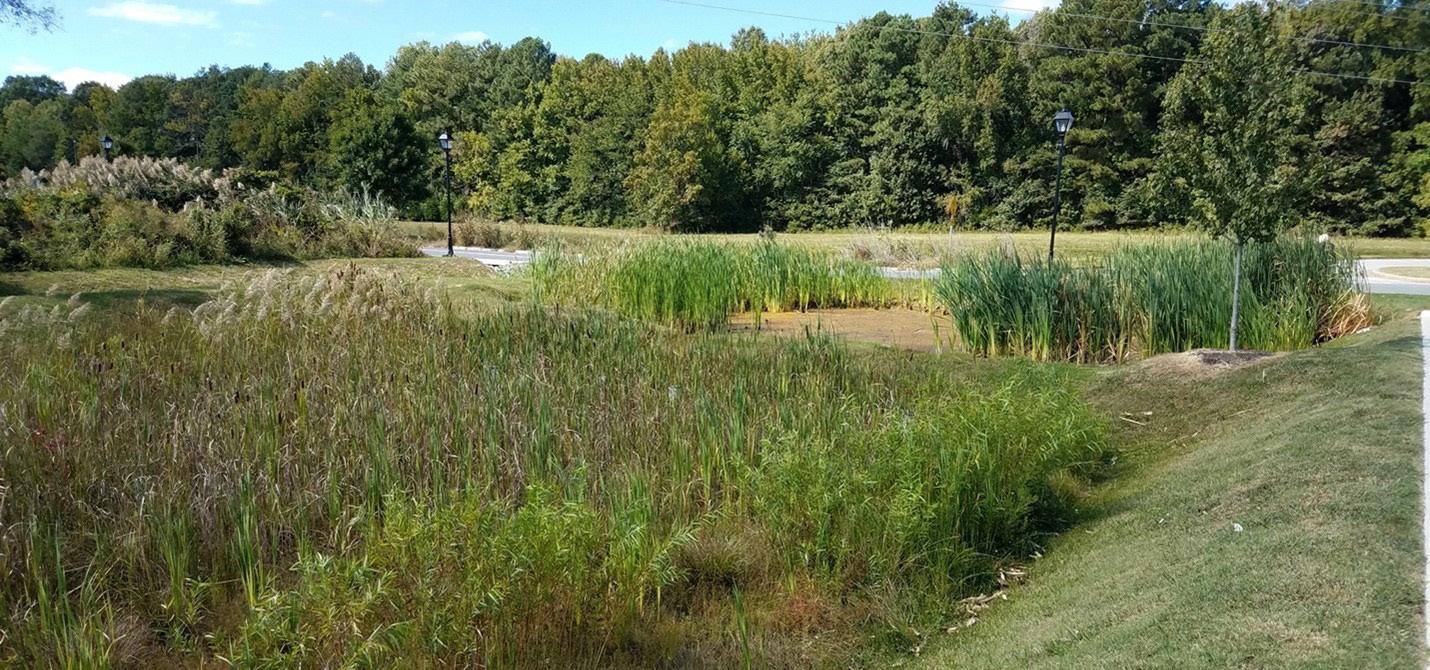
ECOSYSTEM
SERVICES BENEFIT
Storm water Management
Water Quality
Phosphorus Removal
Nitrogen Removal
Water Quantity
Interception
Infiltration
Biodiversity Support
Evaporation
Water Temperature
Carbon Sequestration
Food Chain Supply
Insect Support
Songbird Support
AREA OF FDB GALAXY SITE FOR THIS APPLICATION
Similar to in-channel wetlands, these landscapes constructed adjacent to perennial or intermittent streams are constructed to treat stormwater runoff. They can also absorb different discharge flows and serve as a biofilter in the landscape, removing harmful pollutants, suspended solids, and nutrient loads from stormwater before the discharge reaches a native stream channel. For purpose of discussion 2 acres of the project site on the northern and western portion of the site is identified as a possible location for adjacent to channel constructed wetland.
NC State offered to have Professor Bill Hunt and his Engineering Group work
with FDB to evaluate specific design development recommendations for implementing a constructed wetland. While it is not being pursued as part of Phase One construction for the Galaxy site, it might be considered for future phases of development.
39 Phase 2 Ecosystem Services Benefit
Green Roof
ECOSYSTEM SERVICES BENEFIT
Carbon Sequestration
Air Quality
Wildlife Attractor: Pollinators
Insect Support
Storm water Management
Reduced Emissions
Biodiversity Support
Interception of Rainwater
Water Quality
Water Quantity
AREA OF FDB GALAXY SITE FOR THIS APPLICATION
A green roof, sometimes referred to as a living roof is the structural covering of a building that is partially or completely covered with a specific array of vegetation planted in structural growing medium and planted over a waterproof membrane. A Green Roof may include additional layers of construction such as a root barrier, drainage and irrigation systems.

Yes, a green roof is expensive to install. They are not expensive to maintain, and they return economic benefits in the form of reduced energy costs, improve the lifespan of roof systems and provide numerous ecosystem service benefits. It is a tradeoff in terms of upfront costs
and long-term benefits. For purpose of discussion 200,000 square feet of roof was identified for possible green roof construction.
NC State offered to have experts from the College of Engineering and College of Agriculture and Life Sciences provide technical assistance to FDB on the design and construction of a green roof system for the Galaxy building complex. This was evaluated by FDB and determined to not be a feasible solution for the Galaxy building complex.
40 FujiFilm Diosynth Biotechnologies
Specific Ecosystem Services Strategies
Green Walls
ECOSYSTEM SERVICES BENEFIT
Wildlife Attractor: Pollinators
Insect Support
Songbird Support
Biodiversity Support
Air Quality
Air Temperature
Atmospheric Cleaning
Noise Abatement
Nitrogen Removal
Phosphorus Removal
Visual Screening
AREA OF FDB GALAXY SITE FOR THIS APPLICATION
A Green Wall is a vertical structure intentionally covered with specific types of vegetation. They are also referred to as living walls or vertical gardens, and widely associated with the delivery of many beneficial ecosystem services. Green walls include a vertically applied growth medium such as soil, substitute substrate, or hydroculture felt; as well as an integrated hydration and fertigation delivery system.
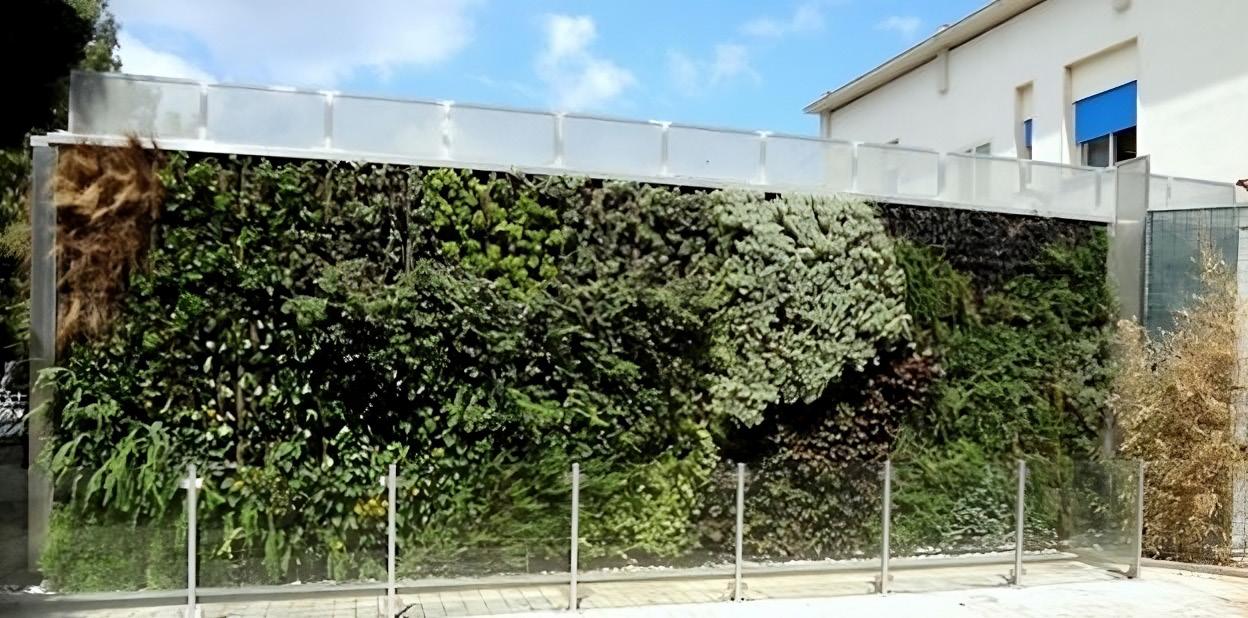
Green walls could be located throughout the FDB site, placed strategically around landscapes that support both human and wildlife ecosystem services. Green walls can be grown in very small, linear landscapes, and are typically
supported by building walls or structures independent of walls. For purpose of discussion 1,500 square feet is identified as potential green wall development.
NC State offered to have the College of Engineering and College of Agriculture and Life Sciences provide technical assistance to FDB on the design and construction of a green wall systems for the Galaxy building complex. This is not a part of the Phase One development and can be considered for development in later phases.
41 Phase 2 Ecosystem Services Benefit
November 2021 Budgets: Design Development Strategies
The following is provided for information only. It offers FDB a range of costs for implementing the ecosystem services design strategies that have been featured in this report.
42
$2,500 to $4,000
$300 to $500 per acre
$12,500 to $25,000 per acre
$250 to $500 per acre
$500 to $1,000 per acre
$1,500 to $2,500 per acre
$12.00 to $14.00/sq. ft.
$50,000 to $80,000
$6,000 to $10,000
$500,000 to $1 million
$175,000 to $350,000
$20,000 to $40,000
$750,000 to $1.2 million $1.3 million to $1.5 million
$67,000 to $150,000
$680,000 to. $850,000
8.00/sq. ft.
$100,000 to $200,00 per acre
$125,00 to $200,000 per acre
$20 to $30 per square foot
$100 to $200 per square foot
***
$75,000 to $121,000
$100,000 to $200,000
$250,000 to $400,000
$4 million to $6 million
$150,000 to $300,000
43
STRATEGY BUDGET RANGE UNIT SIZE UNIT COST
Bioretention Bioswale
Pavement Infiltration Trench In Channel Wetland Adjacent Wetland Green Roof Green Wall 20 acres 20 acres 40 acres 68 acres 40 acres 50 acres 106,722 sq. ft. 14,810 sq. ft. 42,253 sq. ft. 14, 375 sq. ft. 1 acre 2 acres 200,000 sq. ft. 1,500 sq. ft
These budgets were developed by NC State University for use on the FujiFilm Diosynth Biotechnolgies Galaxy Site in Holly Springs, NC.
DESIGN
Wildflower Meadow Sunflower Crop Landscape Plantings Forest Restoration Wildlife Habitat Aquatic Restoration
Permeable
acre
per
$5.00 to $10.00/sq. ft. $16.00 to $20.00/sq. ft. $5.25 to
44 Initiative for Community Growth + Development design.ncsu.edu/about/community-growth-initiative/NorthCarolinaStateUniversity ©2023 All Rights Reserved An NC State University College of Design Publication Printed in the USA
46







































